Nottinghamshire Birdwatchers' visit to Anglesey
2nd July 2006
Trip Report by Neil Glenn
Photographs by Robert Brown (Cemlyn Tern in flight) and the four others by Lynne Demaine
As we traversed the motorways and A–roads to north Wales there was a mixed reaction to England’s dumping out of the World Cup the previous day. Some were in sombre mood whilst others considered it a blessed relief. The discussion made the journey pass quickly and we reached South Stack on Anglesey before 10.00am.
A quick trawl along the surrounding roads had failed to produce any Choughs but I was confident we would see some on our walk around the reserve. What the drive did reveal was a flock of Llamas. I know we are in another country but this is ridiculous!
We disembarked from the minibus and opinion was divided once more: some thought the cool wind and spots of rain a refreshing change from yesterday’s unbearable heat and humidity whilst others donned hats and winter coats!
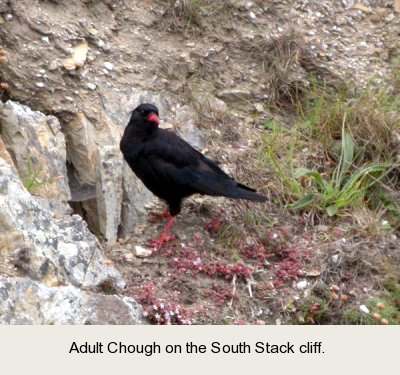
As we neared the cliff edge, two Choughs flew in front of us and disappeared behind the headland. Not all the group saw them so it was a relief when three more appeared followed by four more. We all admired them through telescopes as we watched two adults feed a couple of begging youngsters.
Our attention was momentarily drawn to a Hummingbird Hawkmoth in front of us followed by three Ravens cavorting over the headland. This was proving to be an excellent start to the day!
We moved to the observation tower and sheltered from the wind against the wall. From this vantage point each member of the party managed to see Puffins, Manx Shearwaters, Gannets, Razorbills and Guillemots. This was birdwatching in relaxed style.
A walk across the heath to the minibus added Stonechat and Meadow pipit to the day’s total. We headed off at midday, arriving at Cemlyn Bay half an hour later (ticking off Emu on the way!). From the car park, we could see several birdwatchers already scanning the tern colony. After a quick trudge across the shingle beach we soon joined them.
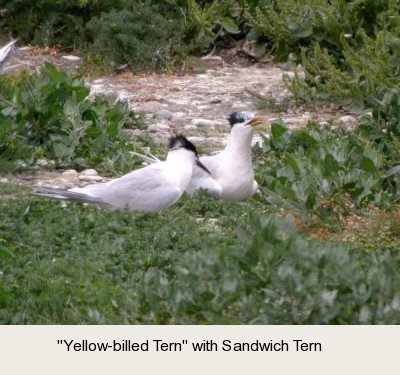
We immediately latched on to the yellow–billed tern that had been causing identification debates over the past few weeks. Some thought it to be a Cayenne Tern, the tropical form of Sandwich Tern but from photographs I thought it too big and bulky for this to be so. I favour the Sandwich × Lesser Crested hybrid option personally. Whatever species, it was certainly a striking bird. It had a blotchy yellow bill, white mottled forehead, a shaggy crest and black and yellow legs. It was also attending a chick, which popped its head up once in a while!
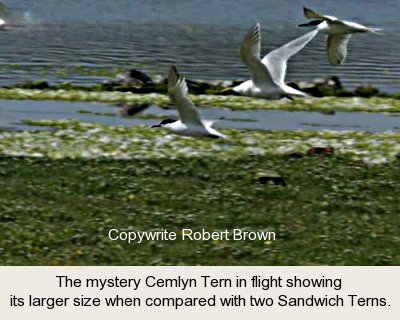
After a few minutes, a Sandwich Tern landed next to the yellow–billed thingy, obviously its mate. A few seconds later, the yellow–billed flew out to sea leaving the group to concentrate on the other goodies on offer
Several elegant Arctic Terns were sitting on nests along with a few Commons and many Sandwiches. There were lots of cute baby Sandwich Terns stumbling in the pool along with juvenile Black–headed Gulls in various stages of development. The whole island was alive with action, terns coming and going from nests and flying out to sea over our heads.
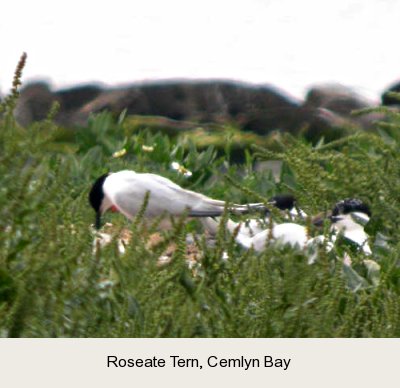
Suddenly, the warden tells us he has seen a Roseate Tern fly in. We all eventually see it as it sits preening on top of the island, partially obscured by vegetation and various other birds. We were able to appreciate its all dark bill and hint–of–a–tint pinky breast, though the long tail feathers had already worn off.
After an excellent morning’s birdwatching, it was time to move to our final port of call: Fedw Fawr. This is a site famous for Black Guillemots but I hadn’t visited it for many years so was a bit vague on directions to the site. Fortunately, I had an OS map and several trusty navigators with me, so off we went.
We reached the general area but couldn’t find the narrow track. Just as we pinpointed our position on the map, we met a convoy of three cars. A local woman in the lead vehicle asked us if we were lost. We were able to tell her no, but checked we were correct just the same. Yes!
We turned a corner and met another local woman who asked us if we were lost. Again we told her no. She pointed to a man sitting in a car and said “he’s lost. And he’s local!” I’m glad we weren’t the only misplaced visitors.
After parking the van, we strolled along a country lane bordered by tall hedgerows. The road led us to the cliff top where the breeze hit us. The sun was now burning down and this draught was most welcome! We quickly found a Black Guillemot as it flew behind the promontory and another could be seen on the sea in the distance.
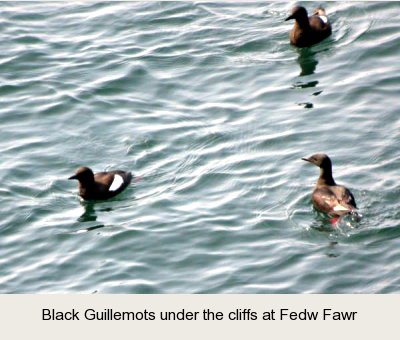
We moved along the headland and were rewarded with very good views of several more Black Guillemots paddling about beneath us in the inviting–looking sea. Just as one of the group commented on how they looked a kindly species, two rose off the sea trying to peck each other’s eyes. They then plummeted back to the surface with a splash before another quick pecking session. “What was that you were saying, Jenny?”
The sea was flat calm, ideal for cetacean–spotting. Just as this thought entered my head, Greg shouted that he had seen a couple of Harbour Porpoises! They only showed a couple more times but most of the group managed to get brief glimpses of them. The sea was also full of white–looking jellyfish.
After this relaxing birdwatch, it was time to head for home. Traffic was very heavy with day–trippers thanks to the scorching weather but some of us were cheered by a Hobby as it zipped across the road. We managed to avoid the flash floods in Cheshire on our journey home, leaving us able to concentrate on choosing our Bird of the Day.
Roseate Tern won the vote, followed by Chough and Black Guillemot. Not surprisingly, the grotty yellow–billed thingy tern received NIL POINTS.
Thanks to my navigators for keeping me on the unstraight and narrow.
For anyone who wants to read a copy of this report in the bath, it can also be found in the July NBW newsletter.
| Birds seen | |
|---|---|
| Mute Swan | 2, Cemlyn |
| Canada Goose | Trent Embankment |
| Shelduck | Beaumaris |
| Fulmar | South Stack & Fedw Fawr |
| Manx Shearwater | Several, South Stack |
| Gannet | South Stack |
| Cormorant | Holyhead |
| Shag | South Stack |
| Grey Heron | |
| Sparrowhawk | Fedw Fawr |
| Kestrel | |
| Common Buzzard | |
| Hobby | 1, A55 |
| Coot | Cemlyn |
| Oystercatcher | Holyhead & South Stack |
| Lapwing | South Stack |
| Curlew | 1, Fedw Fawr |
| Redshank | Holyhead |
| Black-headed Gull | inc juvs |
| Lesser Black-backed Gull | South Stack |
| Herring Gull | |
| Great Black-backed Gull | South Stack |
| Kittiwake | South Stack |
| Sandwich Tern | Cemlyn & Fedw Fawr |
| (yellow-billed mystery tern) | Cemlyn |
| Roseate Tern | 1, Cemlyn |
| Common Tern | Cemlyn |
| Arctic Tern | Cemlyn |
| Guillemot | South Stack, Fedw Fawr |
| Razorbill | South Stack |
| Black Guillemot | up to 15, Fedw Fawr |
| Puffin | A few, South Stack |
| Feral Pigeon | |
| Wood Pigeon | |
| Collared Dove | |
| Swift | |
| Sky Lark | South Stack |
| Swallow | |
| House Martin | Fedw Fawr |
| Meadow Pipit | South Stack & Cemlyn |
| Pied Wagtail | |
| Wren | |
| Stonechat | 2, South Stack |
| Blackbird | |
| Whitethroat | Cemlyn |
| Chiffchaff | Heard |
| Willow Warbler | 1 Heard, Fedw Fawr |
| Great Tit | Cemlyn |
| Magpie | |
| Chough | Up to 9, South Stack |
| Jackdaw | |
| Rook | |
| Carrion Crow | |
| Raven | 3, South Stack |
| Starling | Several largeish flocks |
| House Sparrow | |
| Chaffinch | Fedw Fawr |
| Greenfinch | |
| Bullfinch | 1, Fedw Fawr |
| Mammals | |
|---|---|
| Harbour Porpoise | 2, Fedw Fawr |
| Rabbit | |
| Seal spp | South Stack |
| Butterflies & Moths | |
|---|---|
| Hummingbird Hawkmoth | 1, South Stack |
| Red Admiral | |
| Speckled Wood | |
| Ringlet | |
